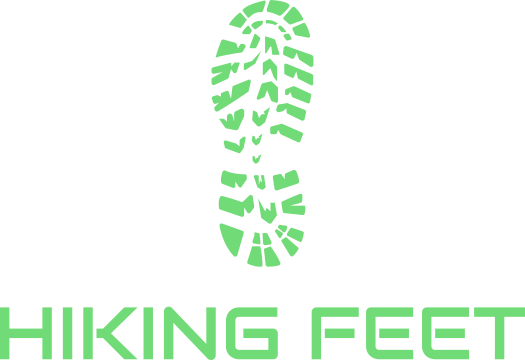The Brooks Cascadia was one of the first trail running shoes that drew the attention of thru-hikers on long-distance trails. Now in its 17th iteration, is this traditional trail runner still a viable shoe for hikers? For the past nine months, I've hiked off and on in the Cascadia to find out. My Brooks Cascadia 17 review will help you figure out if this traditional trail runner is a good fit for your feet and good match for your hikes.


This post includes affiliate links. If you click on an affiliate link and purchase something, the retailer may share a small percentage of the sale with Hiking Feet. That doesn't cost you anything and gives you an easy way to support this site's free and independent content.
Brooks Cascadia 17 review
As always, my Brooks Cascadia 17 review is based on first-hand experience and my professional experience in the outdoor gear industry. I've owned the Cascadia 17 since fall 2023 and subjected my pair to a series of test hikes designed to evaluate its support, weight, fit, comfort, weather protection, tread, and overall value. Since I hadn't worn Brooks since the '90s, I requested a demo pair of Cascadias for this review. A Brooks rep graciously provided me with a pair with the understanding that my review was 100% independent—it's not sponsored or influenced by Brooks. Here's my hiker's review of the Brooks Cascadia 17, based on several test hikes around Rothrock State Forest, Moshannon State Forest, and the Ridges and Valleys region of Pennsylvania.
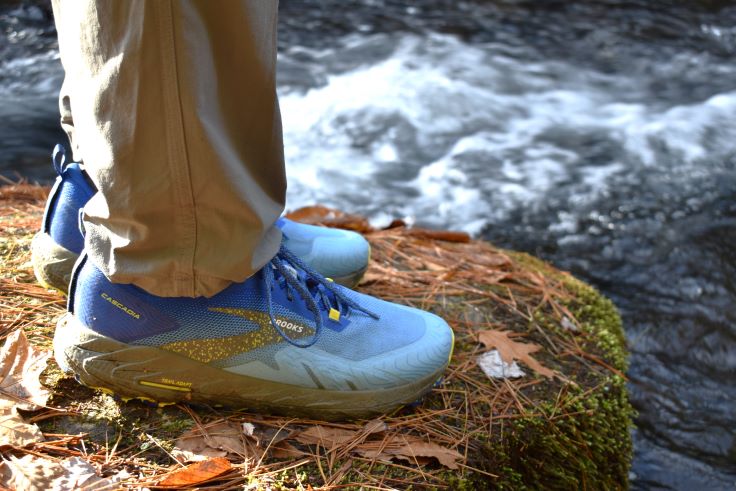
Testing the Brooks Cascadia 17 in Moshannon State Forest (PA)
Support
Good for a trail running shoe
Trail running shoes do not provide as much support as traditional hiking shoes. However, the Brooks Cascadia comes close. The soles are relatively thick for a trail runner, and a stability plate keeps the Cascadia stiff throughout the midfoot, adding torsional rigidity and limiting flexibility to modest flex around the balls of my feet. TPU overlays add some toe protection and stability in the heel. It's one of the more supportive trail runners I've reviewed (along with the La Sportiva Ultra Raptor 2 and LOWA Fortux). Most of my test hikes took place on steep and rocky Pennsylvania trails, such as the Mid-State Trail and Standing Stone trail, and my feet and ankles felt relatively supported as I hiked (and occasionally ran) through rock gardens and snarls of tree roots.

Weight
My men's size 12 weighs 1lb 11oz per pair. That's 3 ounces heavier than most trail runners I recommend but a few ounces lighter than the lightweight hiking shoes I recommend. Overall, the Brooks Cascadia profiles best as trail running shoe for hikers who care more about support than weight savings.
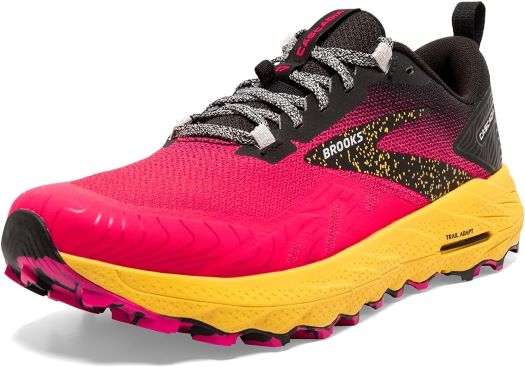
Women's Cascadia 17
Fit
Roomy
The Brooks Cascadia 17 runs true to size with a roomier fit than most trail running shoes. It runs slightly wide in the forefoot and toe box, providing enough room for my moderately wide feet. My everyday shoe size is a 11.5, and I fit comfortably in a regular size 12. (I often need a 12 wide or size up to 12.5+ to get enough width for hiking.) Among trail running shoes, this is one of the wider options. I recommend it to hikers who want a wider toe box or need a wider fit.
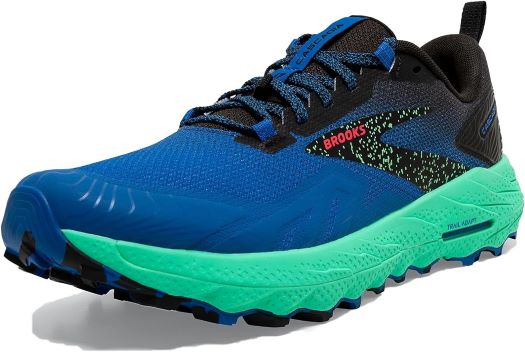
Comfort
Average
Comfort has a lot to do with fit, personal preferences, and matching your footwear to your specific end use. Personally, I like this shoe's relatively roomy fit (which might feel too wide to narrow-footed hikers). Its build is moderately stiff, but light and responsive DNA Loft foam provides moderate cushioning. The Cascadia is fairly firm underfoot with a moderate, 8mm drop from heel to toe—nothing unusual, nothing special. It's a traditional trail running shoe.
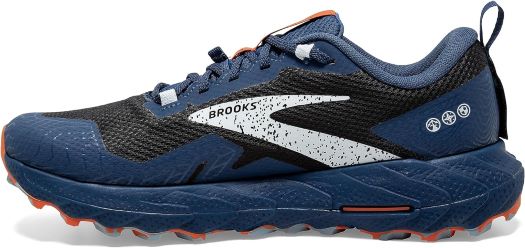
Brooks Cascadia 17 GTX (GORE-TEX waterproofing)
Weather Protection
Available in GORE-TEX
Most hikers prefer non-waterproof trail running shoes because they don't run as warm and dry quicker when they do get wet. That's why I reviewed the regular, non-waterproof version of the Cascadia 17. Its TPU overlays do shed some moisture, but the Cascadia isn't made for weather protection. However, it is available in a GORE-TEX waterproof package, the Cascadia 17 GTX, for muddy or snowy hikes.
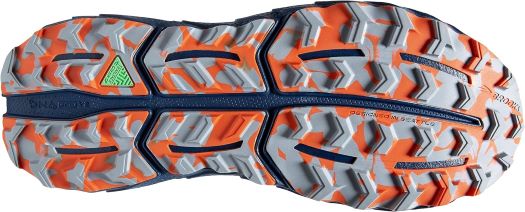
Traction
Moderately aggressive
The Brooks Cascadia features moderately deep, V-shaped lugs. This tread pattern is better for dirt, mud, and gravel than solid rock. Most lugs are oriented towards forward propulsion (since it's a running shoe), not braking. That makes the Cascadia okay on steep downhills but better on climbs and mixed terrain. Pennsylvania's mountains aren't big, but the footing often sucks. On my test hikes, I was confident in the Cascadia's tread on moderate hikes and steep ascents. I've never taken a tumble or bumbled around the trail in my Cascadias. However, I have had to slow down my descents on steeper trails with loose footing, such as the Kettle Trail, since there's no heel brake and only a few braking lugs. Overall, the tread is pretty versatile and appropriate for moderately difficult trails.

Value
GOOD
The Cascadia 17 retails for $140 ($30 more for the GTX/GORE-TEX waterproof version). With the prices for trail running shoes skyrocketing, that's now average to slightly below average for the best trail runners for hikers. Reasonable comps are the Salomon XA Pro ($140) and La Sportiva Ultra Raptor ($149). Given their sturdy build, Cascadias should be pretty durable, too.
Click to see size and color options:


Brooks Cascadia 17: Pros vs. Cons
Based on my first-hand review of the Brooks Cascadia 17, here's my take on the shoe's pros and cons:
Overall recommendation:
Based on my personal experience, I recommend the Brooks Cascadia to hikers who prefer a more traditional trail running shoe—one that's pretty tough and supportive for a trail runner. If you're a hiker who wants to try a trail running shoe for weight savings but don't want to lose all the support of hiking shoe, the Brooks Cascadia would be a good call. It's not light by today's trail runner standards, but it's several ounces lighter than traditional hiking shoes—and almost as supportive. It's also wider than the other traditional trail runners that I recommend for hikers, the Salomon XA Pro (see my review) and La Sportiva Ultra Raptor II (see my review). I can see why thru-hikers first flocked to this shoe, but I like it as an everyday hiker. My pair of Brooks Cascadias has held up to some tough day hikes in Pennsylvania—"where hiking boots go to die" (Bill Bryson)—and should serve me well in the high desert when I soon move back to the Southwest.
If you're feeling the Cascadia, please consider purchasing your pair through the affiliate links above. That's doesn't cost you anything, but the retailer may share a small percentage of the sale with Hiking Feet. That helps keep this site afloat and gives me a little something back for the hundreds (thousands?) of hours I've spent writing free content to help others find shoes that fit their feet and match their hikes. Thanks for supporting Hiking Feet!
